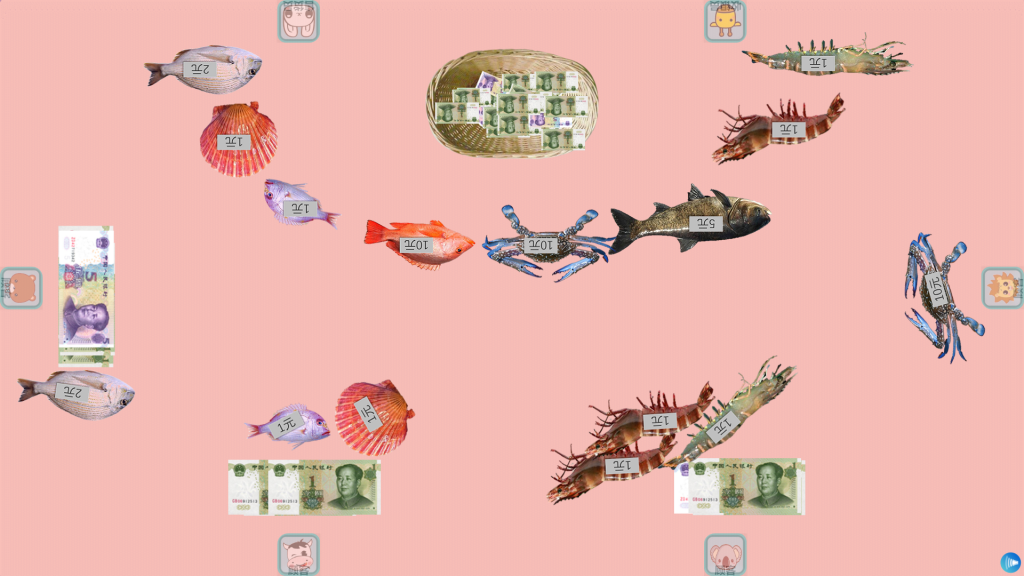
Activity goal
This courseware is suitable for learning the addition and subtraction of numbers 10-20. This lesson plan uses the number 10 as an example to design activities. The goals are as follows:
- Understand 1 yuan and 5 yuan, and be able to apply them in daily life;
- Learn the decomposition and composition of the number 10, as well as addition and subtraction operations;
- Actively participate in discussions on mathematical activities.
Event preparation
The scene is set to 5 people. This activity is suitable for 5 children per table. They naturally form a group and choose a group leader.
Experience preparation: Know the decomposition and composition of numbers within 9, and initially master the addition and subtraction operations of numbers within 9.
Activity process
01Visit the seafood market
Have you ever eaten seafood? What kind of seafood do you know?
Today the teacher will take you to visit a seafood market.
Understand the classification and names of seafood (based on the child’s acceptance level, the name is used as an understanding)
(Large screen display courseware screen) The seafood market is undergoing transactions. Let’s find out what seafood is available here and what categories it is. (from left to right)
Fish: flat snapper, redshirt, red snapper, bullhead
Shellfish: red scallop
Shrimp: Penaeus monodon, Penaeus chinensis
Crab: Pelagic swimming crab
Know the price of seafood
Have you noticed, children, that there are labels on seafood? Can anyone tell the teacher what is written on the labels? This is the price of seafood, ranging from 1 yuan, 2 yuan, 5 yuan, and 10 yuan.
Let’s take a look at the seafood that sells for 1 yuan? There are scallops, redfish, and two kinds of shrimp
What about the one priced at 2 yuan? flat snapper
There is big head fish for 5 yuan
The items priced at NT$10 include red snapper and distant sea swimming crab.
(From left to right: flat snapper 2 yuan, red scallop 1 yuan, red striped fish 1 yuan, red snapper 10 yuan, sea swimming crab 10 yuan, bullhead fish 5 yuan, monodon shrimp 1 yuan, Chinese prawn 1 Yuan.)
Get to know RMB
In this seafood market, besides seafood, what else can children find? Yes, there is a basket for loose money, and there are RMB in the basket and on the table. Take a look, how many yuan does it cost? There is one that costs 1 yuan. What are its characteristics? Green with the number 1 on it. There is a 5 yuan one, it is purple and has the number 5 on it.
02Learn the decomposition and composition of 10, and the addition and subtraction of numbers within 10
(The teacher finds the coin in the courseware, drags it and explains it, and uses a game to teach the decomposition and composition of the number 10, as well as the addition and subtraction of numbers within 10)
The elder sister has one 5-yuan RMB note, and the younger sister has 5 1-yuan RMB notes. Are they both the same number? What does that add up to?
Dad gave them some more money. Now my sister has 10 yuan (1 yuan for 5 yuan + 5 yuan for 1 yuan), and she bought scallops for 1 yuan. Guess how much money she has left? If she buys another 2 yuan of fish, how much is left…
My sister also has 10 yuan (1 ticket for 5 yuan + 5 tickets for 1 yuan). She bought a big-head fish for 5 yuan. Children, think about it, how much money does your sister have? My sister bought two more shrimps worth 1 yuan. How much money does she have left…
03 Buying and selling seafood on Medo Interactive Desk
➤The staff at the seafood market saw that our children were very good at counting, and they were quick and accurate. They invite children to experience seafood trading at the market. Do you want to try it?
➤A child in each group plays the role of a salesperson, responsible for selling seafood and collecting money. Four children play the role of customers and use the 10 yuan in front of you to buy their favorite seafood.
➤Can be carried out multiple times, with group members taking turns playing the role of salesperson.
➤Multiple choices of activity methods:
1) Independent transactions: Customers can purchase seafood at will. 2) Purchase according to the specified quantity, for example: each customer uses 5 yuan and keeps 5 yuan. It costs 10 yuan per customer. Each customer buys 3 kinds of seafood, and finally calculates how much money is left. The group jointly uses 20 yuan to buy seafood (expanding learning on addition and subtraction within 20). The group purchases a fixed amount of seafood together, such as 8 types. The group works together to purchase the largest amount of seafood. The group buys any amount of seafood together and uses up the 10 yuan… 3) After each activity, group members can share with their partners what seafood they bought, how much they spent, and how much is left. 4) After each activity, the group leader will lead the members to check whether the seafood sales are correct, and try to record and report to the teacher.
Summary
♥The seafood buying and selling experience ends here. Do children like this activity?
☑What did you learn from this activity? I got to know the common types of seafood, including fish, shellfish, shrimp, and crab; I got to know the RMB, including 1 yuan and 5 yuan; I learned how to buy and sell seafood; I also learned the decomposition and composition of 10, and the addition of numbers within 10. Subtraction operation.
▣Where else can the skills we learned about buying and selling seafood be used? It can be applied to transactions with a limit of less than 10.
If you are interested in learning more, please contact us
StoneTouch Tech (Zhuhai) Co. Ltd.
3rd Floor, Building 18, Hengqin Macau Youth Entrepreneurship Valley, Zhuhai
Tel:0756-6969319
Email: sales@stonetouch.cn
Website: www.stonetouch.cn
Wechat public account:


